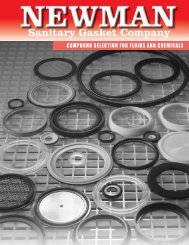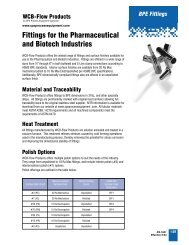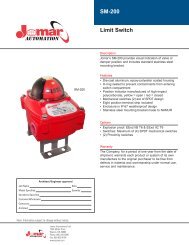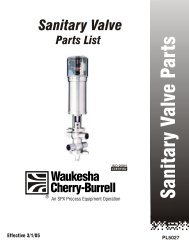WAUKESHA Manuale Inglese UNIVERSAL 1 - Asco Pompe Srl
WAUKESHA Manuale Inglese UNIVERSAL 1 - Asco Pompe Srl
WAUKESHA Manuale Inglese UNIVERSAL 1 - Asco Pompe Srl
Create successful ePaper yourself
Turn your PDF publications into a flip-book with our unique Google optimized e-Paper software.
Problem Probable Causes Solutions<br />
No flow, pump not priming 1. "Air" lock. Fluids which "gas off",<br />
or vaporize, or allow gas to come<br />
out of solution during off periods.<br />
2. Extra clearance rotors, worn<br />
pump.<br />
3. Net inlet pressure available too<br />
low.<br />
4. On "Vacuum" inlet system: On<br />
initial start-up, atmospheric “blow<br />
back“ prevents pump from<br />
developing enough differential<br />
pressure to start flow.<br />
No flow 1. Relief valve not properly<br />
adjusted, or held off seat by<br />
foreign material (flow is being<br />
recirculated to inlet).<br />
Insufficient flow 1. Speed too low to obtain desired<br />
flow.<br />
2. Air leak due to bad seals or pipe<br />
connections.<br />
1. Manual or automatic air bleed<br />
from pump or lines near pump.<br />
2. Increase pump speed, use foot<br />
valve to improve priming.<br />
3. Check net inlet pressure<br />
available, net inlet pressure<br />
required, recalculate system.<br />
Change inlet system as needed.<br />
4. Install check valve in discharge<br />
line.<br />
1. Adjust or clear valve.<br />
1. Check flow-speed curve.<br />
2. Replace seals, check inlet<br />
fittings.<br />
Fluid vaporization<br />
(“starved“ pump inlet)<br />
1. Strainers, foot valves, inlet fittings<br />
or lines clogged.<br />
2. Inlet line size too small, inlet line<br />
too long. Too many fittings or<br />
valves. Foot valve, strainers too<br />
small.<br />
3. Net inlet pressure available at<br />
pump too low.<br />
4. Net inlet pressure required by<br />
pump too low.<br />
5. Net inlet pressure available too<br />
low.<br />
6. Fluid viscosity greater than<br />
expected.<br />
7. Fluid temperature higher than<br />
expected (vapor pressure<br />
higher).<br />
1. Clear lines. If problem continues,<br />
inlet system may require change.<br />
2. Increase inlet line size. Reduce<br />
length, minimize direction and<br />
size changes, reduce number of<br />
fittings.<br />
3. Raise liquid level in source tank.<br />
4. Increase by raising or<br />
pressurizing source tank.<br />
5. Select larger pump size with<br />
smaller net inlet pressure<br />
required.<br />
6. Reduce pump speed and accept<br />
lower flow, or change system to<br />
reduce line losses.<br />
7. Reduce temperature, reduce<br />
speed and accept lower flow or<br />
change system to increase net<br />
inlet pressure available.<br />
Section 4 - Troubleshooting a Pumping System January 2006<br />
Page 12 95-03002










